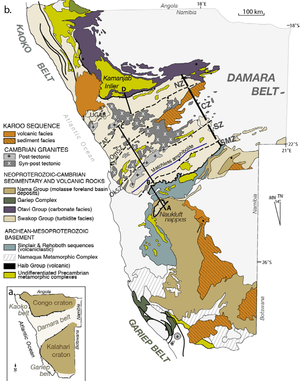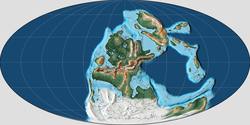Ganigobis Formation
The Ganigobis Formation is a Late Carboniferous (Gzhelian) to Early Permian (Artinskian) geologic formation of the Dwyka Group in the ǁKaras Region of southeastern Namibia and the Northern Cape of South Africa. The widespread formation was deposited in the Aranos and Karoo Basins of southern Africa.
| Ganigobis Formation Stratigraphic range: Gzhelian-Artinskian 302–297 Ma | |
|---|---|
| Type | Geological formation |
| Unit of | Dwyka Group |
| Sub-units | Ganigobis Shale Member |
| Underlies | Ecca Group |
| Overlies | Nama Group |
| Thickness | up to 240 m (790 ft) |
| Lithology | |
| Primary | Shale, conglomerate, sandstone |
| Other | Tuff |
| Location | |
| Coordinates | 25.9°S 18.0°E |
| Approximate paleocoordinates | 56.0°S 35.9°W |
| Region | ǁKaras Region Northern Cape |
| Country | |
| Extent | Aranos & Karoo Basins Kalahari Craton |
| Type section | |
| Named for | Ganigobis |
| Location | Ganigobis, Fish River Canyon |
| Thickness at type section | 155 m (509 ft) |
 Geologic map of Namibia with the Ganigobis Formation partly cropping out in the southern area (orange) | |
Description

The Ganigobis Formation is an extensive unit with a maximum thickness of 240 metres (790 ft) evidenced in the Vreda borehole.[1] The conglomerates, sandstones, shales and tuff of the formation were deposited in a glacio-lacustrine to marine environment.[2][3] The Ganigobis Formation provides fossil fish as well as bivalves (e.g. Nuculopsis), gastropods (e.g. Peruvispira), scyphozoa (e.g. Conularia), crinoid stalks, foraminifera (Hyperammina, Ammodiscus, Glomospira, Ammobacculites and Spiroplectammina),[4] sponges and sponge spicules, radiolaria, coprolites and permineralised wood.[5]
Zircons of the Ganigobis Shale Member yield SHRIMP-ages of 302-300 Ma. This dates the uppermost part of the second deglaciation sequence in southern Namibia to the Late Carboniferous (Gzelian) and provides a minimum age for the onset of Karoo-equivalent marine deposition. The age of the uppermost argillaceous part of the third deglaciation sequence (297 Ma) was determined from zircons of a tuffaceous bed sampled in a roadcut in the Western Cape Province, South Africa.[5]
Fossil content
Among others, the following fossils are reported from the formation:[6][7][8]
- Fish
- Acrolepis addamsi
- Namaichthys schroederi
- Watsonichthys lotzi
See also
References
- Bangert et al., 2000, p.266
- Ganigobis Formation at Fossilworks.org
- Bangert, 2000, p.21
- Bangert, 2000, p.60
- Bangert, 2000, p.3
- Ganigobis at Fossilworks.org
- Wesselton Mine, Kimberley at Fossilworks.org
- Ganigobis, near Tses Station at Fossilworks.org
Bibliography
- Bangert, B.; H. Stollhofen; M. Geiger, and V. Lorenz. 2000. Fossil record and high-resolution tephrostratigraphy of Carboniferous glaciomarine mudstones, Dwyka Group, southern Namibia. Communications of the Geological Survey of Namibia 12. 265–276. Accessed 2018-08-26.
- Bangert, Berthold. 2000. Tephrostratigraphy, petrography, geochemistry, age and fossil record of the Ganigobis Shale Member and associated glaciomarine deposits of the Dwyka Group, Late Carboniferous, southern Africa (PhD thesis), 1–242. Julius-Maximilians-Universität Würzburg. Accessed 2018-08-26.
Further reading
- B. G. Gardiner. 1962. Namaichthys schroederi Gürich and other Palaeozoic Fishes from South Africa. Palaeontology 5(1):9-21